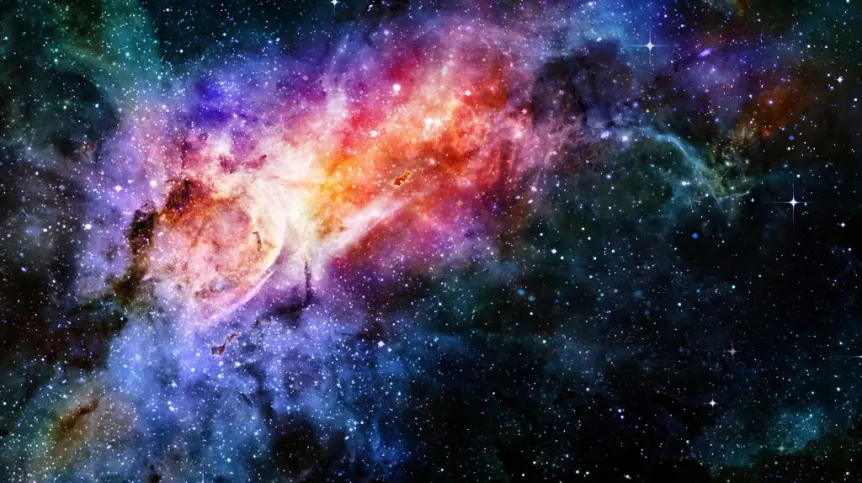
The Great Unification Theory explains what followed the Big Bang. To confirm one of its versions, one must observe proton decay (not yet discovered). Two scholars, including a Polish scientist, proposed a version of the theory without proton decay.
Everything that moves particles in our Universe and keeps them in check comes down to four interactions. These are: gravitational, electromagnetic, strong and weak interactions. It is believed that once - just after the Big Bang - these interactions were one. As the Universe cooled down, they began to separate from each other.
And so now: electromagnetic interaction (between particles with an electric charge) is carried by photons. Strong interaction - which occurs, for example, between quarks - is carried by gluons. And weak interaction - for example, radioactivity exists because of it - is carried by W+ and W- bosons and the Z boson. Gravitational interaction - as it is supposed - could be carried by gravitons (such particles have not been observed yet).
BINDING THEORIES
If we could find a common denominator of all these four interactions and combine their action into a coherent theory, we would get Theory of Everything. That would be something! The problem is gravity, which does not fits in with the other three interactions.
For now, physicists have set a slightly easier task: to describe what happened right after the Big Bang, when three of the four interactions (electromagnetic, strong and weak) were one. The theory that would show the common origin of these forces is called the Great Unification Theory (GUT). (A step lower is the Standard Model, which combines electromagnetic and weak interactions).
STUBBORN PROTONS
Researchers are considering different versions of the Great Unification Theory, but they all have a serious problem - they predict the existence of a specific phenomenon: proton decay.
Proton - component of the atomic nucleus - consists of three quarks and the system may be immutable. Proton decay could be observed experimentally, for example in a pool full of ultrapure water. So scientists around the world, in well-planned experiments, have been staring at such pools for years and looking for signals. But they have not yet recorded traces of decay of even a single proton. So either protons do not decay at all, or decay very rarely - less than once in 10,000 quintile years (a quintile is one followed by 30 zeros).
Researchers were looking for a version of the Great Unification Theory that would predict that the proton might never decay. And that\'s what two scholars - Dr. Bartosz Fornal and Prof. Benjamin Grinstein - have managed to achieve. Research of the scientists from the University of California, San Diego, appeared on Wednesday in the prestigious "Physical Review Letters".
SYMMETRY IS THE AESTHETICS OF FOOLS: BROKEN 5, 10-, 40- AND 50-GONS
In this theory, called four-dimensional Great Unification Theory based on the SU(5) group - particles are present in sets - multiplets. "To describe all the particles of the Standard Model, we need two multiplets: 5 and 10. You can imagine them as a regular pentagon and decagon, their edges are various quarks and leptons. The symmetry of this system can be understood as invariance due to the rotation of such a figure a certain angle "- said Dr. Fornal.
He explained that if the symmetry is broken - imagine as if as the Universe is cooling down, the pentagon and decagon hit the ground and break into pieces - the multiplets break into particles of the Standard Model. "We added a tetracontagon and a pentacontagon to this model. We selected the values of parameters so that when the symmetry is broken, the elements of pentagons and decagons connect to tetracontagons and a pentacontagons and all particles of the Standard Model receive the right masses And at the same time we avoid interactions that cause proton decay" - said Dr. Fornal.
SEARCH FOR THE COLOUR SEXTET
That\'s the theory, but how to check if it is real? For this, one would have to experimentally observe certain characteristic particles predicted by the Polish and American researchers. "One of them is the colour sextet. Its properties are known. The Large Hadron Collider has been looking for these particles for a few years" - said Dr. Fornal. He added that the existence of the colour sextet had already been assumed in some earlier theories. However, both the colour sextet and other particles, the existence of which is proposed in the new version of GUT, are particles with very large masses and may prove to be experimentally inaccessible for the time being. However, it would be possible to register them in accelerators with very high collision energies.
Collision energy in the Large Hadron Collider at CERN is less than 14 teraelectronvolts (thousands of billions of electron volts), and according to Dr. Fornal an accelerator with several times higher collision energy (about 100 teraelectronovolts) would be needed to confirm the new theory. However, to design, finance and build such a powerful accelerator, humanity must make a gigantic effort, and that takes time.
Author: Ludwika Tomala
PAP - Science in Poland
lt/ ekr/ kap/
tr. RL













